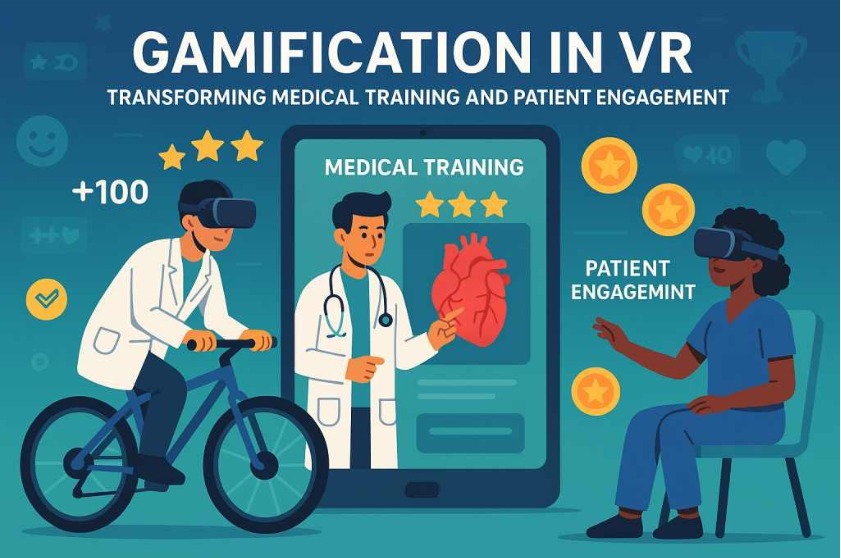In an era where technology intertwines with every aspect of our lives, the healthcare industry is undergoing a profound transformation through the integration of virtual reality (VR) and gamification. This innovative synergy is not only reshaping medical training but also redefining patient engagement. By leveraging the immersive power of VR, medical professionals and patients alike are experiencing a new dimension of interaction that enhances learning, empathy, and healing. In this article, we delve into the multifaceted impacts of gamification in VR on medical training and patient engagement, offering insights into how this technological advancement is charting a new course for healthcare.
The fusion of gamification and VR is a groundbreaking development in the medical field. Gamification, the application of game-design elements in non-game contexts, and VR, a simulated experience that can be similar to or completely different from the real world, together create a powerful tool for medical training and patient care.
Contents
- 0.1 Defining Gamification in VR
- 0.2 The Technological Backbone
- 0.3 Bridging the Gap between Theory and Practice
- 1 Enhancing Medical Training through Gamified VR
- 2 Immersive Learning Environments
- 3 Adaptive Learning and Skill Assessment
- 4 Transforming Patient Engagement with Gamified VR
- 5 Empowering Patients through Interactive Therapies
- 6 Reducing Anxiety and Pain through VR Distraction
- 7 The Future of Gamified VR in Healthcare
- 8 Opportunities for Game Developers
- 9 A Call to Action for the Gaming Community
- 10 Conclusion
Defining Gamification in VR
Gamification in VR involves integrating game-like elements such as points, badges, and leaderboards into virtual reality experiences. These elements are designed to make medical training and patient interactions more engaging and motivating. In medical training, these game elements help simulate real-world scenarios, encouraging active participation and enhancing the learning process.
The Technological Backbone
The technology behind VR and gamification includes advanced hardware and software that create a seamless and immersive experience. Devices like VR headsets and motion sensors enable users to interact with virtual environments in a way that feels real. The software is equally crucial, providing the framework for creating detailed, interactive simulations that mimic real-life medical scenarios.
Bridging the Gap between Theory and Practice
One of the significant benefits of gamification in VR is its ability to bridge the gap between theoretical knowledge and practical application. By immersing trainees in realistic scenarios, VR enables them to apply what they’ve learned in a controlled environment. This hands-on approach enhances understanding and retention, making it easier for trainees to transition to real-world medical settings.
Enhancing Medical Training through Gamified VR
The traditional methods of medical training, while effective, often lack the interactive and engaging components that gamification offers. By integrating gamified VR into medical education, trainees can experience realistic simulations that provide immediate feedback and adaptive learning environments.
Realistic Simulations for Skill Development
Gamified VR offers realistic simulations that allow medical trainees to practice complex procedures in a risk-free environment. These simulations mimic the challenges and pressures of real-life medical situations, helping trainees develop the skills and confidence needed for their future careers. Through repeated practice, trainees can refine their techniques and improve their decision-making abilities.
Interactive Feedback and Performance Metrics
In gamified VR training, immediate feedback is a crucial component. Trainees receive instant evaluations of their actions, helping them understand what they did right and where they need improvement. This feedback, combined with detailed performance metrics, allows trainees to track their progress over time. Educators can also use these metrics to identify areas where trainees might need additional support or practice.
Collaborative Learning and Peer Interaction
VR platforms often include features that facilitate collaborative learning and peer interaction. Trainees can work together in virtual environments, simulating team-based medical procedures. This collaboration helps them develop essential communication and teamwork skills, which are vital in real-world medical settings. By working with peers, trainees can also learn from each other’s experiences and insights, enhancing the overall learning process.
If you’re planning to develop a custom medical VR solution, it’s essential to hire video game developers who understand not just technical VR development, but also the sensitivity and complexity of medical procedures. Their expertise ensures that the final product is both educationally valuable and technically robust, helping bridge the gap between theory and hands-on clinical experience.
Immersive Learning Environments
One of the primary advantages of VR in medical training is the creation of immersive environments that closely mimic real-life scenarios. Trainees can perform complex procedures in a risk-free setting, allowing them to develop skills and confidence without the fear of real-world consequences.
Simulating High-Stakes Scenarios
Immersive VR environments allow trainees to engage in high-stakes scenarios, such as emergency surgeries or critical care situations. By simulating these intense experiences, trainees learn to manage stress and make quick, informed decisions. This preparation is invaluable, as it equips them with the skills needed to handle pressure in actual medical emergencies.
Customizable Training Modules
VR platforms offer customizable training modules that can be tailored to specific medical disciplines or procedures. This flexibility allows educators to design targeted training experiences that address the unique needs of their trainees. By focusing on specific skills or scenarios, trainees can gain a deeper understanding of their chosen field and become more proficient in their practice.
Enhancing Empathy and Patient Communication
Immersive VR environments also play a crucial role in developing empathy and improving patient communication skills. By placing trainees in the shoes of patients, VR helps them understand the patient experience, fostering a more compassionate approach to care. Additionally, trainees can practice communication techniques, ensuring they are prepared to interact effectively with patients in real-world settings.
Adaptive Learning and Skill Assessment
Gamification in VR also facilitates adaptive learning, where training modules adjust to the learner’s pace and performance. This personalized approach ensures that each trainee receives targeted feedback and support, fostering a more effective learning experience.
Personalizing the Learning Experience
Adaptive learning in VR personalizes the training experience by adjusting the difficulty and pace of simulations based on the trainee’s performance. This customization ensures that trainees are continually challenged without becoming overwhelmed. As a result, they can learn at their own pace, making the educational process more efficient and effective.
Data-Driven Insights for Educators
VR systems equipped with analytics tools provide educators with data-driven insights into trainee performance. These insights help identify strengths and weaknesses, allowing educators to tailor training programs to meet individual needs. This targeted approach ensures that trainees receive the support they need to succeed, optimizing the overall learning experience.
Continuous Improvement and Skill Mastery
Adaptive learning and skill assessment in VR promote continuous improvement and skill mastery. Trainees receive ongoing feedback and opportunities to refine their skills, ensuring they are continually advancing in their training. This focus on mastery helps trainees build the confidence and competence needed to excel in their medical careers.
Transforming Patient Engagement with Gamified VR
Beyond training, gamified VR is revolutionizing patient engagement by offering novel ways to interact with healthcare services. From pain management to rehabilitation, VR is enhancing the patient experience by making it more interactive and enjoyable.
Creating Engaging Rehabilitation Experiences
For patients undergoing rehabilitation, gamified VR provides an engaging platform that transforms traditional exercises into interactive games. This transformation makes therapy more enjoyable and motivating, encouraging patients to stick with their treatment plans. By participating in these engaging experiences, patients are more likely to achieve better health outcomes and improve their quality of life.
Virtual Reality in Chronic Disease Management
Gamified VR also plays a role in managing chronic diseases by offering interactive tools for monitoring and self-care. Patients can use VR to track their symptoms, learn about their condition, and engage in therapeutic exercises. This interactive approach empowers patients to take an active role in their health, leading to better disease management and improved overall well-being.
Enhancing Patient Education and Empowerment
VR provides patients with an immersive platform for education, helping them understand their medical conditions and treatment options. Through interactive simulations, patients can learn about procedures, potential outcomes, and self-care techniques. This education empowers patients to make informed decisions about their healthcare, enhancing their engagement and satisfaction with their treatment.
Empowering Patients through Interactive Therapies
For patients, gamified VR offers an engaging platform for therapy and rehabilitation. By transforming traditional exercises into interactive games, patients are more motivated to participate in their treatment plans. This increased engagement can lead to better adherence to therapy regimens and improved health outcomes.
Motivation through Gamified Exercises
Gamified exercises within VR environments provide patients with a sense of achievement and progress. By incorporating rewards and challenges, these exercises keep patients motivated and engaged in their rehabilitation. This motivation is crucial for long-term adherence to therapy regimens, ultimately leading to improved health outcomes.
Personalized Therapy and Progress Tracking
VR platforms offer personalized therapy experiences that cater to individual patient needs. By adjusting the difficulty and focus of exercises, VR ensures that patients receive the most effective treatment for their condition. Additionally, progress tracking features allow patients and healthcare providers to monitor improvement over time, fostering a sense of accountability and accomplishment.
Fostering a Positive Mindset
The interactive and rewarding nature of gamified VR exercises helps foster a positive mindset in patients. By focusing on achievements and progress, patients are more likely to maintain a hopeful outlook on their recovery. This positivity can enhance the overall effectiveness of therapy and contribute to better mental and emotional well-being.
Reducing Anxiety and Pain through VR Distraction
Gamified VR also plays a significant role in pain management and anxiety reduction. The immersive and distracting nature of VR can transport patients to calming environments, helping them cope with pain and anxiety during medical procedures.
Immersion as a Pain Management Tool
Immersive VR environments serve as powerful tools for pain management by distracting patients from discomfort during medical procedures. By engaging patients in calming and engaging virtual experiences, VR reduces the perception of pain and enhances overall comfort. This non-pharmacological approach to pain management offers a valuable alternative to traditional methods.
Addressing Anxiety with Calming Simulations
For patients experiencing anxiety related to medical procedures, VR provides calming simulations that promote relaxation and stress reduction. By transporting patients to serene virtual environments, VR helps alleviate anxiety, making medical experiences less intimidating. This reduction in anxiety can lead to smoother procedures and improved patient satisfaction.
Enhancing the Patient Experience
By reducing pain and anxiety, VR enhances the overall patient experience, making healthcare more pleasant and less daunting. Patients who have positive experiences with VR are more likely to engage with healthcare services and adhere to treatment plans. This improved engagement contributes to better health outcomes and a higher quality of care.
The Future of Gamified VR in Healthcare
The integration of gamification and VR into healthcare is only the beginning. As technology continues to evolve, the potential applications of gamified VR in medicine are limitless. From telemedicine to remote training, VR is poised to become an integral part of healthcare delivery.
Expanding Telemedicine with VR
The future of telemedicine is set to be transformed by the integration of VR, offering remote consultations and treatments in immersive environments. Patients will be able to interact with healthcare professionals as if they were in the same room, enhancing the quality of remote care. This expansion will improve access to healthcare services, particularly for those in remote or underserved areas.
Remote Training and Continuous Education
VR will play a crucial role in remote medical training, allowing healthcare professionals to continue their education and skill development from anywhere in the world. This flexibility will enable continuous learning and professional growth, ensuring that medical practitioners stay up-to-date with the latest advancements in their field. By making training more accessible, VR will contribute to a more competent and knowledgeable healthcare workforce.
Integrating AI and Machine Learning
The future of gamified VR in healthcare will likely involve the integration of AI and machine learning, further enhancing the capabilities of these technologies. AI-driven analytics will provide deeper insights into patient and trainee performance, enabling more personalized and effective experiences. This combination of technologies will lead to more efficient healthcare delivery and improved patient outcomes.
Opportunities for Game Developers
For game developers, the rise of gamified VR in healthcare presents a unique opportunity to contribute to meaningful advancements in medicine. By collaborating with medical professionals, developers can create innovative VR solutions that address specific healthcare challenges.
Designing for Impact
Game developers have the chance to design VR experiences that have a direct impact on healthcare outcomes. By focusing on user needs and incorporating evidence-based practices, developers can create simulations that effectively address medical training and patient engagement challenges. This focus on impact ensures that VR solutions are not only innovative but also practical and beneficial.
Collaborating with Medical Experts
Collaboration with medical experts is essential for creating effective VR solutions in healthcare. Game developers can work alongside healthcare professionals to understand the unique challenges and requirements of medical training and patient care. This collaboration ensures that VR experiences are grounded in medical knowledge and tailored to the needs of users.
Innovating for a Better Future
The field of medical VR game development offers endless opportunities for innovation. Developers can explore new ways to enhance training, improve patient engagement, and address healthcare challenges. By pushing the boundaries of technology and creativity, game developers can contribute to a healthier and more connected world.
A Call to Action for the Gaming Community
As members of the gaming community, it is crucial to recognize the transformative potential of gamified VR in healthcare. By engaging in discussions, sharing insights, and supporting initiatives that promote the integration of gaming and medicine, the community can drive positive change and innovation.
Fostering Collaboration and Knowledge Sharing
The gaming community can play a pivotal role in fostering collaboration and knowledge sharing between developers, healthcare professionals, and technologists. By creating platforms for discussion and exchange, the community can facilitate the development of innovative solutions that benefit both the gaming and healthcare industries.
Supporting Research and Development
By supporting research and development initiatives focused on gamified VR in healthcare, the gaming community can contribute to the advancement of this field. This support can take the form of funding, resources, or advocacy, helping to drive innovation and bring new solutions to market.
Inspiring the Next Generation
The gaming community has the opportunity to inspire the next generation of developers and healthcare professionals to explore the potential of gamified VR. By showcasing the impact and possibilities of this technology, the community can encourage young innovators to pursue careers at the intersection of gaming and medicine, ensuring a bright future for this transformative field.
Conclusion
The convergence of gamification and VR in the medical field is revolutionizing the way we approach training and patient care. By providing immersive, interactive, and personalized experiences, gamified VR is enhancing learning, engagement, and health outcomes. As we continue to explore the possibilities of this technology, the role of game developers and the gaming community becomes increasingly important. Together, we can shape the future of healthcare, making it more accessible, efficient, and patient-centered. Let’s embrace the potential of gamified VR and work towards a healthier, more connected world.


